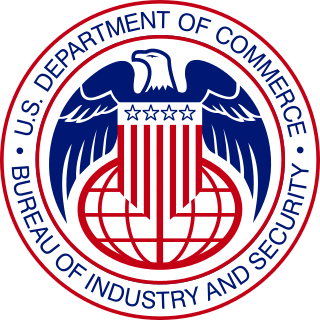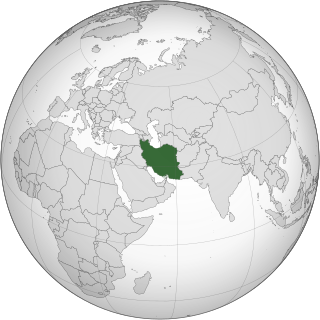Arms control is a term for international restrictions upon the development, production, stockpiling, proliferation and usage of small arms, conventional weapons, and weapons of mass destruction. Historically, arms control may apply to melee weapons before the invention of firearm. Arms control is typically exercised through the use of diplomacy which seeks to impose such limitations upon consenting participants through international treaties and agreements, although it may also comprise efforts by a nation or group of nations to enforce limitations upon a non-consenting country.

The Bureau of Industry and Security (BIS) is an agency of the United States Department of Commerce that deals with issues involving national security and high technology. A principal goal for the bureau is helping stop the proliferation of weapons of mass destruction, while furthering the growth of United States exports. The Bureau is led by the Under Secretary of Commerce for Industry and Security.

The Nuclear Suppliers Group (NSG) is a multilateral export control regime and a group of nuclear supplier countries that seek to prevent nuclear proliferation by controlling the export of materials, equipment and technology that can be used to manufacture nuclear weapons.

An export in international trade is a good produced in one country that is sold into another country or a service provided in one country for a national or resident of another country. The seller of such goods or the service provider is an exporter; the foreign buyers is an importer. Services that figure in international trade include financial, accounting and other professional services, tourism, education as well as intellectual property rights.
The Coordinating Committee for Multilateral Export Controls (CoCom) was established by the Western Bloc in the first five years after the end of World War II, during the Cold War, to put an embargo on Comecon countries. CoCom ceased to function on March 31, 1994, and the then-current control list of embargoed goods was retained by the member nations until the successor, the Wassenaar Arrangement, was established in 1996.

The export of cryptography from the United States to other countries has experienced various levels of restrictions over time. World War II illustrated that code-breaking and cryptography can play an integral part in national security and the ability to prosecute war. Changes in technology and the preservation of free speech have been competing factors in the regulation and constraint of cryptographic technologies for export.

In politics, diplomacy and export control, dual-use items refer to goods, software and technology that can be used for both civilian and military applications.

The Missile Technology Control Regime (MTCR) is a multilateral export control regime. It is an informal political understanding among 35 member states that seek to limit the proliferation of missiles and missile technology. The regime was formed in 1987 by the G-7 industrialized countries. The MTCR seeks to limit the risks of proliferation of weapons of mass destruction (WMD) by controlling exports of goods and technologies that could make a contribution to delivery systems for such weapons. In this context, the MTCR places particular focus on rockets and unmanned aerial vehicles capable of delivering a payload of at least 500 kilograms (1,100 lb) to a range of at least 300 kilometres (190 mi) and on equipment, software, and technology for such systems.
The Export Administration Regulations (EAR) are a set of United States export guidelines and prohibitions. They are administered by the Bureau of Industry and Security which regulates the export restrictions of sensitive goods. The EAR apply to scenarios where something is exported from the US, re-exported from a foreign country, or transferred from one person to another in a foreign country. The EAR apply to physical objects as well as intellectual property such as software.

The Bureau of International Security and Nonproliferation (ISN) is a bureau within the United States Department of State responsible for managing a broad range of nonproliferation and counterproliferation functions. The bureau leads U.S. efforts to prevent the spread of weapons of mass destruction, their delivery systems, advanced conventional weapons, and related materials, technologies, and expertise.
Cryptography is the practice and study of encrypting information, or in other words, securing information from unauthorized access. There are many different cryptography laws in different nations. Some countries prohibit the export of cryptography software and/or encryption algorithms or cryptoanalysis methods. Some countries require decryption keys to be recoverable in case of a police investigation.

United Nations Security Council Resolution 1718 was adopted unanimously by the United Nations Security Council on October 14, 2006. The resolution, passed under Chapter VII, Article 41, of the UN Charter, imposes a series of economic and commercial sanctions on the Democratic People's Republic of Korea in the aftermath of that nation's claimed nuclear test of October 9, 2006.

Small arms and light weapons (SALW) refers in arms control protocols to two main classes of man-portable weapons.
Export control is legislation that regulates the export of goods, software and technology. Some items could potentially be useful for purposes that are contrary to the interest of the exporting country. These items are considered to be controlled. The export of controlled item is regulated to restrict the harmful use of those items. Many governments implement export controls. Typically, legislation lists and classifies the controlled items, classifies the destinations, and requires exporters to apply for a licence to a local government department.

Sten Fredrik Lundbo is a Norwegian diplomat and was Ambassador to the Council of Europe in Strasbourg, France 1995 - 2000 and to the Republic of Poland 2000 - 2005.

A multilateral export control regime is an informal group of like-minded supplier countries that seek to contribute to the non-proliferation of weapons of mass destruction, delivery systems, and advanced conventional weapons through national implementation of guidelines and control lists for exports. For a chart of national membership in different regimes, see the SIPRI Yearbook chapter on "Transfer controls".

United Nations Security Council Resolution 1929, adopted on 9 June 2010, after recalling resolutions 1696 (2006), 1737 (2006), 1747 (2007), 1803 (2008), 1835 (2008) and 1887 (2009) concerning the topics of Iran and non-proliferation, the Council noted that Iran had failed to comply with previous Security Council resolutions concerning its nuclear program and imposed further sanctions on the country.

The Federal Office for Economic Affairs and Export Control is a German federal agency. The BAFA is authorised to make the final decision on whether German goods are permitted for export.
The Technology Alert List (TAL) is a list developed by the United States federal government of critical fields where it would like to limit the transfer of goods, technology, and sensitive information, with the goal of supporting nonproliferation of weapons of mass destruction and nontransfer of U.S.-held technologies. The list is intended as guidance for consular officers reviewing visa applications for activities such as graduate-level studies, teaching, conducting research, participating in exchange programs, receiving training or employment.













